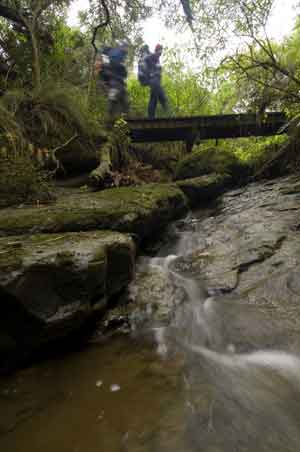
Otway Parks The parks system of the Otways is somewhat fragmented with many towns and areas of private land amongst the 5 parks of the range.
The parks are the Otways National Park, Angahook-Lorne State Park, Carlisle State Park and Melba Gully State Park. The Port Campbell National Park adjoins the Otways National Park.Otways National Park covers 13000 hectares of sea cliffs and forests.
Angahook-Lorne State Park, the closest of the Otway parks to Melbourne is also the biggest at 22,350 hectares. It was declared in 1987 and contains many waterfalls.
Carlisle State Park, declared in 1988, covers 5600 hectares in the northern Otways and is the remotest and least visited park of the range.
Melba Gully State Park is a small park of 65 hectares created in 1975 after the land was donated to the Victorian Conservation Trust.
Port Campbell National Park covers 1750 hectares in a narrow band of coastline extending over fifty kilometres westward from the Otways. It was declared in 1964 and contains much of the coastal scenery that the Great Ocean Road is famous for including the 12 Apostles, Blowhole and Loch Ard Gorge.
View images of waterfalls in the Otway National Park |
History The Otways basin area was beneath the surface of the ocean until around 10 million years ago and former coral reefs have left extensive limestone deposits in the area. The erosion of these deposits has resulted in the spectacular cliffs and other formations that the Great Ocean Road is famous for. Some of these limestone deposits contain dinosaur fossils.
The local Katabanut Aborigines hunted in the coastal woodlands, and would have lit fires to attract animals to the post-fire regrowth. Aboriginal people may have used the land bridge from here to Tasmania when the sea level was lower about 20000 years ago. The area is littered with middens where bones and the remains of shellfish have built up at popular campsites.
The first European settlers were the sealers and whalers followed by graziers and timber cutters. |
|
Parts of the Otways have been logged since the 1880s with many sawmills built.
A network of tramways and a narrow gauge railway (like the Dandenongs' Puffing Billy) carried timber, goods and tourists between Crowes in the central Otways and the main line at Colac.
The Cape Otway lighthouse was built in 1848 to guide ships arriving from Europe around the Cape and into Bass Strait. The coast has still seen a huge number of shipwrecks, the most famous being the Loch Ard, which sank in 1878 with the loss of 52 lives. Tom Pierce and Eva Carmichael, the only two survivors, were washed ashore in the nearby Gorge, which today is a popular stop on the Great Ocean Road. The anchor from the wreck of the Fuji still lies embedded in the sand at Wreck Beach. |
